




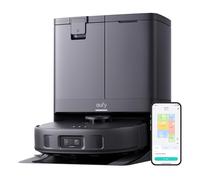

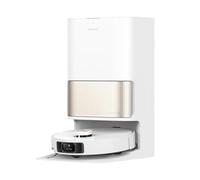
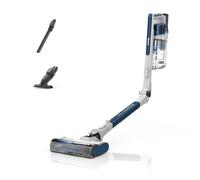
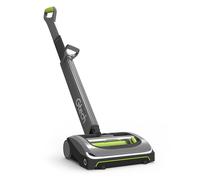


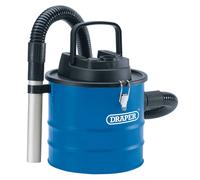
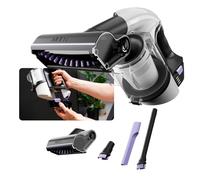


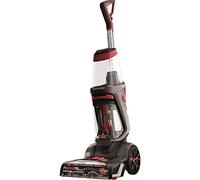
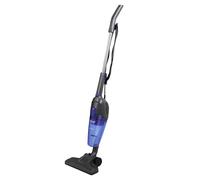

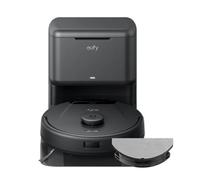
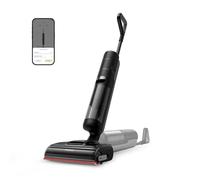
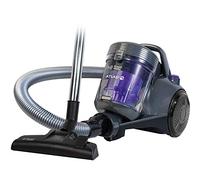
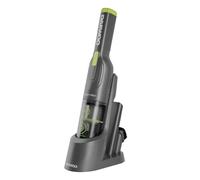



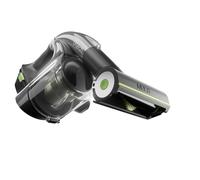
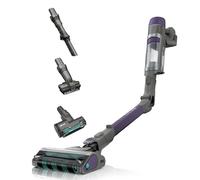
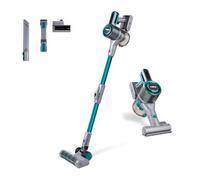

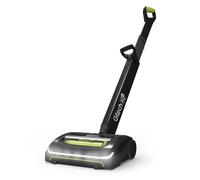


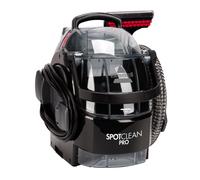


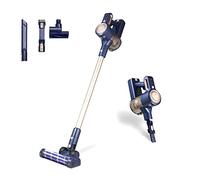
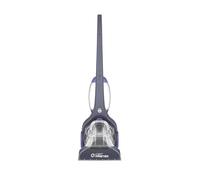


- 1
- 2
- 3
- 4
- 5
- next page
Discover Amazing Offers on Vacuum Cleaners
Due to an EU regulation from 2017, you can only buy vacuum cleaners that have a maximum power consumption of 900 watts. However, it should already have this. Excluded from this regulation are: Battery vacuum cleaners, vacuum cleaner robots, combined wet and dry vacuum cleaners.
The wattage only provides you with information about the power consumption from the socket - i.e. about the power consumption. Accordingly, a high wattage also means more consumption and higher costs.
We can't give you a general answer as to which version of the vacuum cleaner is really better. This depends on the size of your four walls as well as your health and your individual needs.
Classically, bags are used in the vacuum cleaner. However, they have the disadvantage that you have to buy new ones regularly, which results in follow-up costs.
The alternative is the vacuum cleaner without a bag. This is only equipped with a collection container, which you must empty as soon as it is full. The disadvantage of a vacuum cleaner without a bag is that a relatively large amount of dust is stirred up when emptying it. This is not exactly beneficial for the health of allergy sufferers.
If you suffer from dust allergies or similar, we recommend a vacuum cleaner with HEPA or ULPA filters.
These filters trap dust particles as small as 0.3 microns. This way, the smallest particles such as pollen, bacteria and dust mite excretions won't even get to you.
If you just bought a new vacuum cleaner and it smells a little funny, don't worry. That smell will literally disappear into thin air.
However, if your vacuum cleaner with bag is older, this can be caused by the following:
- Vacuum cleaner bag too full.
- Dirty dust mite filter.
- Sucking up water, liquids or damp dust.
Even a bagless vacuum cleaner can spread unpleasant odours. With cyclone technology, for example, heat is generated by the rotary movement. If there are still moist dust flakes in the container, the vacuum cleaner will eventually start to smell.
If you can rule out all these causes, the motor may be defective. There is often an increase in heat in it, which burns dust or scorches plastic in the vacuum cleaner.
The easiest way to get your vacuum cleaner odour-free is to replace the dust bag. In addition, the trade also has so-called vacuum cleaner deodorants in the form of scented sticks, essential oils or pearls ready for you.
If you have a bagless vacuum cleaner, we recommend wiping out the container from time to time with disinfectant and a damp kitchen towel. This prevents the formation of unpleasant odours.
In addition to the dust bag, you should also regularly change the two other filters of your vacuum cleaner. These are the motor protection filter and the exhaust filter.
The motor protection filter is located between the motor and the dust bag compartment. It is particularly important if you have forgotten to insert a bag, if it is not seated properly or if it has burst.
Usually a motor protection filter consists of coarse fleece or mesh, which sits in a plastic device. How often you have to change this filter can be found in the instruction manual of your vacuum cleaner. Manufacturers often advise you to change the filter twice a year or at the latest as soon as there is visible dirt.
The exhaust filter, also known as the blow-out or micro filter, cleans the air before it enters the room again. You should also change it twice a year.
Some manufacturers recommend washing, drying and reusing the exhaust filter, whereas specialist lights advise against this for hygienic reasons.
Furthermore, some vacuum cleaners have filter cassettes for exhaust air cleaning instead of exhaust air filters made of fleece. This is often the case with vacuum cleaners with a HEPA filter. They are made of folded, fleece-like filter paper that traps the smallest dust particles. How often you change this type of filter depends on how often you use your vacuum cleaner.
We advise you to store your vacuum cleaner in a place where it will stay free from moisture and frost.
So the basement is not so ideal. However, if you have no other option, place a blanket or tarp under the unit. Under no circumstances should you store it in your wardrobe, because you're bound to have sucked up small animals during the vacuuming process, and you don't want to find them in your clothes.
Usually, a separate closet for cleaning supplies is the perfect place to store your ironing board and iron as well.
In addition, some manufacturers offer their vacuum cleaners with a wall mount. This way, you can hang the device in a suitable place and it won't get in the way.
Under no circumstances should you dispose of your old vacuum cleaner in the household waste or bulky waste. Although both options are still common, they are prohibited by the Electrical and Electronic Waste Act. The reason for this is that many different small parts are built into vacuum cleaners, which can sometimes contain harmful substances.
However, there are a few ways to dispose of your old vacuum cleaner properly and free of charge if you use one of the following three options:
- Returning it to the dealer.
- Use a private collection service.
- Drop off at a collection point for electronic waste.
Handing in at an electronic waste collection point is often the easiest method. Almost every municipality has such a collection point. If you prefer to take it to the dealer, no problem. They are obliged by law to take it back. Most of the time they ask for a proof that you bought the device there.
In addition, some municipalities have e-waste collection services that will dispose of your old vacuum cleaner free of charge. They often drive to certain locations on fixed dates and pick up your e-waste.
Discover Amazing Offers on Vacuum Cleaners
If you're looking for the perfect vacuum cleaner, you'll find a wide array of options available on pricehunter.co.uk. Whether you need a lightweight model for quick clean-ups or a powerful pet vacuum, our service helps you compare prices from multiple retailers to find exactly what you need. Let's delve into the essential aspects to consider when selecting your vacuum cleaner.Types of Vacuum Cleaners
Choosing the right type of vacuum cleaner is crucial to meet your specific cleaning needs. Here are some popular types to consider:- Stick Vacuum with Cord - Ideal for quick, everyday clean-ups.
- Upright - Offers powerful suction for deep cleaning carpets and larger spaces.
- Canister - Versatile and efficient for both carpets and hard floors.
- Handheld - Perfect for small messes and tight spaces.
- Robot - Automated cleaning that saves time, great for busy households.
Key Features to Consider
When shopping for a vacuum cleaner, understanding key features can help streamline your decision. Focus on these aspects:- Good Cordless Vacuum - Provides the freedom to clean without being tethered to a wall outlet.
- Suction Power - Higher suction power means more effective cleaning.
- Filtration System - HEPA filters are essential for allergy sufferers.
- Noise Level - Quieter models are more family-friendly, especially in shared living spaces.
- Storage Options - Look for designs that are easy to store or compact for small spaces.
Popular Brands in the Market
Several brands dominate the vacuum cleaner market, each offering unique features and reliability. Here are some top contenders:- Best Pet Vacuum Cleaner - Known for tackling pet hair and dander with specialized tools.
- Shark - Offers a range of versatile models with innovative technology.
- Dyson - Renowned for powerful suction and modern designs.
- Hoover - A long-standing brand with reliable and affordable options.
- Black+Decker - Known for compact and easy-to-use handheld vacuums.
Smart Technology Integration
Modern vacuum cleaners are increasingly incorporating smart technology. Consider these features:- Eufy Robot Vacuum - Offers app control and scheduling capabilities for effortless cleaning.
- Wi-Fi Connectivity - Control your vacuum through your smartphone or voice assistants.
- Mapping Technology - Smart vacuums can learn the layout of your home for efficient cleaning paths.
- Automatic Dirt Disposal - Some models empty themselves, saving you time and effort.
- Custom Cleaning Modes - Tailor your cleaning routine based on room type or surface.
Usage Scenarios and Target Audiences
Different users require different vacuum solutions based on their lifestyle and needs. Identify your scenario:- Black Decker Handheld Vacuums - Perfect for quick clean-ups, especially for busy families.
- Pet Owners - Look for vacuums designed specifically to handle pet hair.
- Allergy Sufferers - Opt for models with advanced filtration systems for cleaner air.
- Small Apartment Dwellers - Compact models are optimal for limited storage space.
- Large Households - Consider powerful, high-capacity vacuums for extensive cleaning jobs.